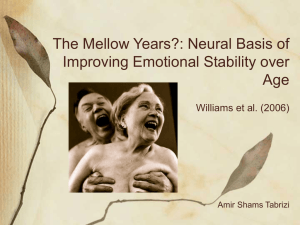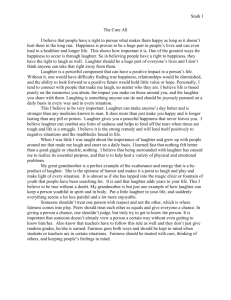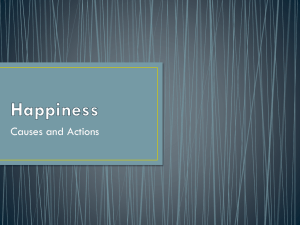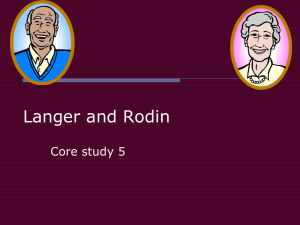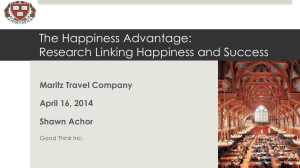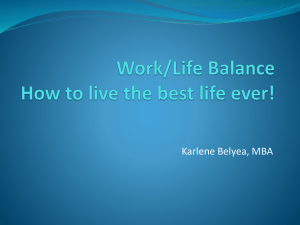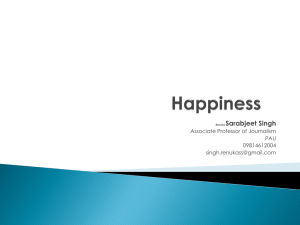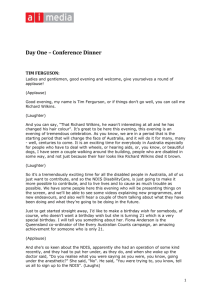now (.zip) - Greater Good - University of California, Berkeley
advertisement
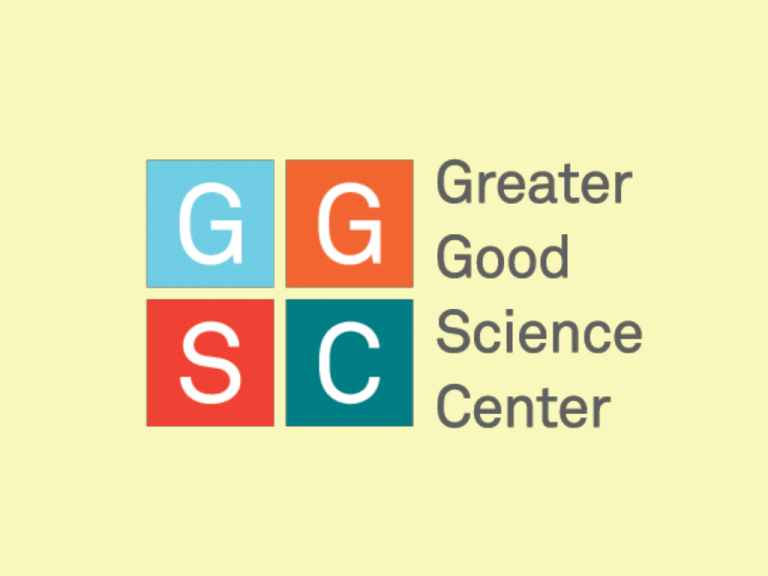
Science of Happiness April 27, 2012 Dacher Keltner University of California, Berkeley keltner@berkeley.edu GreaterGood.berkeley.edu Happiness and health Diener, Lyubomirsky • Happy nuns at 22 are 2.5 times less likely to die between 80 and 90 • Happy about aging adds 7.5 years to life • Happy at 70 adds 20 months to life • Happiness associated with – Fewer health symptoms – Fewer strokes – Fewer fatal accidents – Reduced cardiovascular disease – Reduced allergic reaction Happiness at work • Most cheerful college students make $25,000/year compared to least cheerful • Happy workers more productive, better job performance • Happiness leads to boost in creative thought, problem solving • Happiness makes for more integrative negotiators • Emotionally intelligent managers have more satisfied teams UK Ho lla Sw nd e De d en nm ar Fi k nla d Sw Sp itz ain er la No nd rw ay Ita Ire ly l Be an d lg Ge ium rm a Ca ny na Gr da ee c Po e lan Cz d ec Fr h a Po nce rtu g Au a l s Hu tria ng ar y US Children's well-being Our culture needs it 20 18 16 14 12 10 8 6 4 2 0 A few caveats • The pursuit of happiness… makes us less happy (Gruber & Mauss, 2011) • Negative emotions are part of the mix • Positive emotions in extremes can be problematic (e.g., proneness to mania) What is a happiness, the meaningful life? -- Jen -- Hiking in the Sierras -- Moderation -- Understanding self -- Virtue -- Standing out from others -- Eudamonia -- Fulfilling duties -- Justice -- Rising in status -- Financial well-being -- Giving -- Democracy -- Delicious burrito -- Reunion with family -- Success at work -- Being in love POSITIVE EMOTION: A language for the 3 to 1 (own life) and 5 to 1 ratios (Marriage) • • Resources Social Relations Enthusiasm Approach Goal Contentment Satiation Love Attachment Desire Reproduction Compassion Nurturance Pride Elevated Status Gratitude Reciprocity/Friendship Awe • • Distress Reduction Knowledge Leaders Relief Interest Learning Amusement Transformation/Insight Evolution of a hypersocial species Dimensions to our ultrasociality • • • • • Care-taking Flattened Hierarchies Conflict and Reconciliation Coordination Fragile Monogamy Reward: prefrontal cortex and nucleus accumbens Knutson • Rich with dopamine receptors • Dopamine: Wanting • Opiates: Liking • Activated by: – – – – – pretty faces food, music pleasurable scenes winning money heroin, amphetamines, cocaine The dopamine, opiate interplay DePue Positive emotion and hemispheric asymmetry Davidson The Left Frontal Cortex is associated with language, approach, and Positive Emotion – Emotion Studies – Studies of Buddhist Monks – Studies of Meditation The prosocial nervous system % Who Give Away Maximum Oxytocin and Trust 60 50 40 30 20 10 0 Oxytocin Control Positive emotion in the voice? Simon-Thomas et al., 2009, Emotion Vocal bursts of positive emotion Simon-Thomas et al., 2009 100 90 80 70 60 50 40 30 20 10 0 STRESS and the hypothalamic pituitary adrenal (HPA) axis Chronic stress and – Vigilance to threats – Increased feelings of vulnerability, isolation, lack of control, threat – Stress, anxiety, fear, and nervousness – Immune system compromised, ulcers, damage to DNA, damage to brain cells, shortened lives in response to disease Gratitude • The feeling of reverence for things that are given Emmons, 2007, Thanks Gratitude as guide to good life Emmons, McCullough, 2001 • Barometer Tracks generosity in relationships • Motive Clark: thanked participants more likely to help Kurzban (2001): touched participants more likely to cooperate with stranger • Reward “thank you” on bill: 11% higher tips Volunteerism (to home for elderly) • Baseline return: 43% • Sent thank you notes: 80% The grateful disposition McCullough et al., 2002 • I have so much in life to be thankful for • If I had to list everything I’m thankful for, it would be a very long list • When I look at the world, I don’t see much to be thankful for • I am grateful to a wide variety of people • As I get older I find myself better able to appreciate the people, events, and situations that have been part of my life history • Long amounts of time can go by before I feel grateful to someone or something Correlates of being grateful • Grateful disposition – Life satisfaction .53*** – Happiness .50*** – Optimism .51** – Anxiety -.20* – Depression -.30** – Peer rate volunteerism .19* – Envy -.17** – Possessiveness -.34** A brief history of awe Keltner & Haidt, 2003 • Early conversion experiences, being in presence of God • • • • – St Paul’s conversion – Vismaya in Hinduism Burke’s revolution (1757): secular awe – Patterns light, dark – Ox vs. cow – Not smells – Power, obscurity Immanuel Kant (1764): An Essay on the Sublime and the Beautiful – Aesthetic experience vs. awe Emerson (1860s): Transcendent self in Nature Max Weber (1905): political awe A family of awe experiences Keltner & Haidt, 2003 Vast God X Leader X Elevation Accom Threat Beauty Virtue Supernatural X X X X X Tornado X X Cathedral X X X Music X X Aesthetics X X X X ? ? Emerson In the woods, we return to reason and faith. There I feel that nothing can befall me in life-- no disgrace, no calamity (leaving me my eyes), which nature cannot repair. Standing on the bare ground, — my head bathed by the blithe air and uplifted into infinite space, — all mean egotism vanishes. I become a transparent eyeball; I am nothing; I see all; the currents of the Universal Being circulate through me; I am part or parcel of God. The name of the nearest friend sounds then foreign and accidental; to be brothers, to be acquaintances, master or servant, is then a trifle and a disturbance. I am the lover of uncontained and immortal beauty. “Nature”(1836/1982), p.39 Spirituality and health • Myers: Spiritually oriented report higher levels of happiness • Smith, McCullough, 2003: Spiritually oriented report less depression – 145 studies, 98,000 participants – R = -.096, greater during stress • Putnam: greater spirituality greater volunteerism, altruism – Norenzayan, 2010: Prime spiritual, civic ideas, become more generous • McCullough et al.,2000 – Meta analysis 42 studies: religious 29% more likely to be alive at any time point • McCullough et al., 2009 – Terman longitudinal study: 1523 high IQ people – Three curves • • • • Always religious: Extraverts, neurotics Always non-religious Become more religious: Agreeable Religious women live longer, due to social commitments, health behaviors Play Reflection on play: Your play history, narrative Brown, 2009 • Think back to your earliest experiences of play. What were they? • Are you as free as you’d like to play today? What is play? • Peek-a-boo, rough-and-tumble, games, sociodramatic play, word play, imitations, interspecies play • Criteria: – Apparently purposeless – Voluntary – Inherent attraction – Freedom from time – Diminished consciousness of self – Improvisational – Desire to continue Stuart Brown, 2009 The functions of play • Boundaries – Rough-and-tumble play: learn boundaries between pleasure, pain, harm – Marc Bekoff: coyotes in rough-and-tumble play learn how not to bite, learn hierarchies – Flirtation: learn boundary between friend, intimate The functions of play • Skills – Playful imitation – Play kissing of pre-adolescents – Boys playing cavemen, girls playing with dolls: – hunting, care-taking The functions of play • Identity: – sociodramatic play (3 years) – Barrie Thorne studied lunchtime play of middle school girls: gender play to take on, try out sexual identities – Adolescents play at adults The functions of play • Knowledge – Playing with liquids, sand: understand substance, materials, conservation The functions of play • To learn empathy, theory of mind in pretend play (Leslie) – Abuse of language in pretend play • Object substitution: banana = phone • Attribution of non-literal properties: glasses have diamonds • Imaginary objects – Abuse of rules of language in pretend play frees children from egocentrism, paves way for theory of mind, different perspectives, empathy A language of laughter • Preuschoft, Van Hooff: pant hoots in primates • Provine: Laughter punctuates speech • Bachorowski: hisses, snorts, guffaws, cackles, grunts • 3-4 bursts per laugh • Voiced laughs involve vocal folds • Dominant, submissive laughs The acoustics, physiology of laughter • Own space in acoustic structure (Bachorowski) • Predates language • CNS correlates in brain stem, pons (which regulations breathing: Wilibald Ruch) Laughter = humor? • Provine, 1992 – Laughter gatherers in dorms, malls – About 20% of laughs follow jokes, humor – Most do not Laughter = cooperation? Bachorowski, Owren • Laughter has a unique idiosyncratic acoustic signature • It signals imminent rewards, sign of cooperation • Friends engage in antiphonal laughter (Smoski & Bachorowski, 2003) Laughter and health Martin & Lefcourt • Reduction of cardiovascular stress • Quicker return to cardiovascular baseline during stress (Fredrickson & Levenson,1998) • Laughter cascades benefit marriage (Gottman, 2003) • Martin, Lefcourt: sense of humor benefits health The fool (jokester, trickster, satirist) • • • • • Human universal: from China to original peoples Pervasive in earlier culture Political power, advising Mocked every public event Embodied a rhetoric of absurdity Emotional disorders as deficits in self-compassion • Self-compassion – See failures kindly – See self as part of larger humanity – Hold pains in mindful attentiveness • Self-compassion predicts – – – – Reduced Reduced Reduced Reduced anxiety depression rumination neurotic perfectionism Bipolar disorder and mania • Excessive episodes of positive emotion, then depression • Hyperactivity, difficulties sleeping, grandiosity, impulsivity • Excessive positive emotion • Dysregulation of nucleus accumbens • Excessive confidence • Excessive feelings of power • Excessive vagal tone 60 50 40 High Risk 30 Low Risk 20 10 0 Neutral Happy Pride Sad Disgust Laughter and stressful trauma Bonanno & Keltner, 1995 • Bereavement • Studied 45 adults 6 months bereaved • Simple narrative: “tell me about your relationship with • • your deceased spouse” Coded emotion with FACS Griefwork hypothesis – – – – – Lots of anger a sign of effective grieving Positive emotion sign of denial, maladaptive grieving Our findings: more laughter, better functioning two years later More anger: worse functioning Laughter: physiological arousal not distressing, more perspective The dynamic interaction style perspective • Naturalistic methods • The Four Horsemen of the Apocalypse - Contempt - Criticism - Stonewalling - Defensiveness Beyond 15%: Toward the magical 5 to 1 ratio of positive to negative • Humor: playful nicknames, laughter and escapes from negative affect cascades, playful teasing • Gratitude: Appreciation exercises boost happiness of couples • Loving Kindness: interventions boost happiness of couples (Neff) • Forgiveness: letting go of grudges calms stress-related physiology; forgiveness interventions boost well-being • Disclosure: Suppressing emotion elevates stress-related physiology of others • Idealization (Sandra Murray) Positive emotion in major disorders • Schizophrenia Kring, UC Berkeley – Lack of expression, but comparable feeling – Deficits in anticipating pleasures but comparable experiences savoring pleasures • Depression – Deficits in pride Gruber et al., 2011 Connect • Strong support leads to lower levels of cortisol Kiecolt-Glaser • Give stressful speech with supportive member in audience, lower blood pressure • Women with breast cancer who are in supportive group therapy better life expectancy (37 vs. 18 mos.) Spiegel et al., 1989 • Your connections spread outward Gratitude Diaries (count your blessings) • McCullough, Emmons, 2003: Expressions of gratitude once a week for 10 weeks, better health, happiness 3 weeks later compared to: baseline control condition, a complaint condition • Lyubomirsky: 1 time a week write down what you’re grateful for, boosts in happiness; every day gratitude practice, no effects • Gratitude diaries promote – Reduced blood pressure – Better peer relations in kids – Boosts in test scores for kids Emmons, 2008 Narrative • Write about strongest emotions of trauma, or the facts of the event • Traumas studied: bereavement, divorce, holocaust survivors, 9-11 victims • Effects: increased well-being, enhanced immune function, reduced visits to health center, reductions in anxiety, depression • Narratives about positive self Laura King Contemplation Alan Wallace: Genuine Happiness • Attention – Breathing • Settle into relaxed posture • Focus attention in between what you’re looking at and eyes • Breathe 21 times • Attend to movements of lungs • Mindfulness – Of body • Imagine attention as curved surface • Move this attention up and down body • Be mindful of sensations throughout body • Loving Kindness – Bring to mind a person who is dear to you – Imagine person’s sufferings, yearnings – Wish for person’s happiness – Extend to another person, broadening circle of care Cultivating awe Life style choices Roger Walsh, AP, 2011 • Food – Rainbow diet (Fruit, vegetables) – High omega fish – Less fat • Nature • Exercise The benefits of green • Frances Kuo (2001) – In green regions of Chicago Housing project, 48% fewer property crimes, 56% fewer violent crimes – Girls with green views score higher on self-discipline, delay of gratification, impulse control, concentration – ADHD symptoms drop after walking in park compared to quiet urban area – In regions of Chicago project with more trees and grass, neighbors felt greater community, knew each other, safer Green and health • Ulrich (1991) – Green scenes de-activation heart rate, blood pressure – Heart surgery patients exposed to green scenes need less strong pain medications Restorative justice Sherman & Strang, 2007 • 1500 programs in US, Europe • Principles – – – – Offenders accountable Undo effects of harm Offenders reintegrate into community Respectful dialogue victim, offender • Outcome data (McCullough, 2008) – Victims 4 times less revenge – 2.6 times more likely to forgive offender – Less angry, more pleased with judicial process Touch and be touched • • • • Reward Reinforce Reciprocity Signal Safety Soothe Touch and be touched Frequency Choosing Correct Emotion Emotion and Touch 70 60 50 40 30 20 10 0 r t r e on ude o v ge ea us i L An F sg ss a tit i a r D p G om C Correct Label Next choice Coding Touch You are a part of the Greater Good Participate! Sign up on the site for our monthly e-newsletter. It’s FREE. Volunteer … we appreciate virtual help. Got an hour a week? We need you. Become a member to support our work, and enjoy benefits! Follow us on Facebook and Twitter Consider a tax-deductible donation Write to us at greater@berkeley.edu

